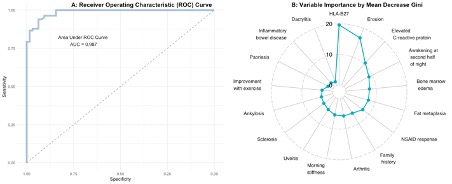Session Information
Session Type: Poster Session C
Session Time: 9:00AM-11:00AM
Background/Purpose: In axial spondyloarthritis (axSpA), early diagnosis plays a key role in preventing disease progression. However, a validated diagnostic algorithm does not exist, while classification criteria are frequently misused diagnostically.
This study aimed at identifying which decision model is being used for diagnosing patients with axSpA based on evaluations made in daily practice.
Methods: Complete clinical data of 399 patients who presented with chronic back pain in a specialized university clinic were retrospectively evaluated. All patients received complete rheumatologic examination. The total dataset was randomly split into training and test datasets at a 7/3 ratio. A model was built to classify patients into axSpA and non-axSpA based on the random forest algorithm, an ensemble machine learning technique which allows computing the importance of each variable in the statistical modelling process. The Mean Decrease Gini measure was used for the variable importance. The overall accuracy, sensitivity, specificity, and the area under the receiver operating characteristic (ROC) curve (AUC) in the test dataset were calculated.
Results: In total, 183 patients were diagnosed with axSpA and 216 with non-SpA (Table 1). In the test dataset, the model reached an accuracy of 0.9315, a sensitivity of 0.9634, a specificity of 0.8906, and an AUC of 0.9868 (Fig. 1A). HLA-B27 positivity, erosion on SIJ MRI, and elevated CRP played the most important role in the statistical modelling process followed by awakening at second half of night due to back pain and bone marrow edema and fat metaplasia on SIJ MRI (Fig. 1B).
Conclusion: Machine learning-based random forest classifier revealed a high performance in diagnosing patients with chronic back pain with axSpA and excluding patients with non-SpA using clinical, laboratory and imaging characteristics as evaluated in a daily practice scenario of a SpA-specialized clinic. External validation of the model is needed to investigate its clinical utility as a diagnostic decision support tool.
To cite this abstract in AMA style:
Redeker I, Tsiami S, Eicker J, Kiltz U, Kiefer D, Andreica I, Sewerin P, Baraliakos X. Identification of a Diagnostic Model for Axial Spondyloarthritis in Daily Clinical Practice Using a Random Forest Machine Learning Approach [abstract]. Arthritis Rheumatol. 2023; 75 (suppl 9). https://acrabstracts.org/abstract/identification-of-a-diagnostic-model-for-axial-spondyloarthritis-in-daily-clinical-practice-using-a-random-forest-machine-learning-approach/. Accessed .« Back to ACR Convergence 2023
ACR Meeting Abstracts - https://acrabstracts.org/abstract/identification-of-a-diagnostic-model-for-axial-spondyloarthritis-in-daily-clinical-practice-using-a-random-forest-machine-learning-approach/


